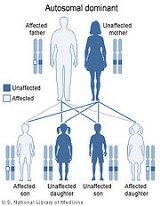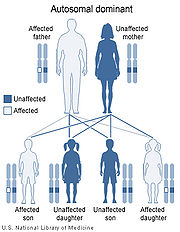
Familial amyloid polyneuropathy
Encyclopedia
Familial amyloid polyneuropathy (FAP), also called transthyretin-related hereditary amyloidosis, transthyretin amyloidosis or Corino de Andrade's disease, is an autosomal
dominant neurodegenerative disease. It is a form of paramyloidosis, and was first identified and described by Portuguese neurologist
Mário Corino da Costa Andrade
, in the 1950s. It is a fatal and incurable disease.
, paresthesia
, muscular weakness and autonomic dysfunction. In its terminal state, the kidneys and the heart
are affected. FAP is characterized by the systemic deposition of amyloidogenic variants of the transthyretin
protein
, especially in the peripheral nervous system
, causing a progressive sensory and motorial polyneuropathy
.
 FAP is caused by a mutation of the TTR
FAP is caused by a mutation of the TTR
gene, located on human chromosome
18q12.1-11.2
. A replacement of valine by methionine at position 30 (TTR V30M) is the mutation most commonly found in FAP. The variant TTR is mostly produced by the liver.
FAP is inherited in an autosomal dominant manner. This means that the defective gene responsible for the disorder is located on an autosome
(chromosome 18 is an autosome), and only one copy of the defective gene is sufficient to cause the disorder, when inherited from a parent who has the disorder.
, FAP is invariably fatal.
in Portuguese locations Póvoa de Varzim
and Vila do Conde (Caxinas), with more than 1000 affected people, coming from about 500 families, where 70% of the people develop the illness. It was brought by Vikings from Scandinavia
during the Middle Age
. In northern Sweden
, more specifically Piteå
, Skellefteå
and Umeå
, 1.5% of the population has the mutated gene. There are many other populations in the world who exhibit the illness after having developed it independently.
and preliminary results suggest it slows progression of the disease.
and TUDCA treatment (in human tolerable doses) significantly lowered fibrillar Transthyretin
(TTR) amyloid deposition in transgenic TTR mice models. The authors propose this treatment in FAP, particularly in the early stages of disease.
Autosome
An autosome is a chromosome that is not a sex chromosome, or allosome; that is to say, there is an equal number of copies of the chromosome in males and females. For example, in humans, there are 22 pairs of autosomes. In addition to autosomes, there are sex chromosomes, to be specific: X and Y...
dominant neurodegenerative disease. It is a form of paramyloidosis, and was first identified and described by Portuguese neurologist
Neurologist
A neurologist is a physician who specializes in neurology, and is trained to investigate, or diagnose and treat neurological disorders.Neurology is the medical specialty related to the human nervous system. The nervous system encompasses the brain, spinal cord, and peripheral nerves. A specialist...
Mário Corino da Costa Andrade
Corino Andrade
Mário Corino da Costa Andrade was a leading twentieth century Portuguese neurologist and researcher who first described the familial amyloidotic polyneuropathy syndrome that later came to be associated with his name .Corino was a founder of the Instituto de Ciências Biomédicas Abel Salazar, a...
, in the 1950s. It is a fatal and incurable disease.
Characteristics
Usually manifesting itself between 20 and 40 years of age, it is characterized by painPain
Pain is an unpleasant sensation often caused by intense or damaging stimuli such as stubbing a toe, burning a finger, putting iodine on a cut, and bumping the "funny bone."...
, paresthesia
Paresthesia
Paresthesia , spelled "paraesthesia" in British English, is a sensation of tingling, burning, pricking, or numbness of a person's skin with no apparent long-term physical effect. It is more generally known as the feeling of "pins and needles" or of a limb "falling asleep"...
, muscular weakness and autonomic dysfunction. In its terminal state, the kidneys and the heart
Heart
The heart is a myogenic muscular organ found in all animals with a circulatory system , that is responsible for pumping blood throughout the blood vessels by repeated, rhythmic contractions...
are affected. FAP is characterized by the systemic deposition of amyloidogenic variants of the transthyretin
Transthyretin
Transthyretin is a serum and cerebrospinal fluid carrier of the thyroid hormone thyroxine and retinol binding protein bound to retinol. This is how transthyretin gained its name, transports thyroxine and retinol...
protein
Protein
Proteins are biochemical compounds consisting of one or more polypeptides typically folded into a globular or fibrous form, facilitating a biological function. A polypeptide is a single linear polymer chain of amino acids bonded together by peptide bonds between the carboxyl and amino groups of...
, especially in the peripheral nervous system
Peripheral nervous system
The peripheral nervous system consists of the nerves and ganglia outside of the brain and spinal cord. The main function of the PNS is to connect the central nervous system to the limbs and organs. Unlike the CNS, the PNS is not protected by the bone of spine and skull, or by the blood–brain...
, causing a progressive sensory and motorial polyneuropathy
Polyneuropathy
Polyneuropathy is a neurological disorder that occurs when many peripheral nerves throughout the body malfunction simultaneously. It may be acute and appear without warning, or chronic and develop gradually over a longer period of time. Many polyneuropathies have both motor and sensory...
.
Cause and genetics

Transthyretin
Transthyretin is a serum and cerebrospinal fluid carrier of the thyroid hormone thyroxine and retinol binding protein bound to retinol. This is how transthyretin gained its name, transports thyroxine and retinol...
gene, located on human chromosome
Chromosome
A chromosome is an organized structure of DNA and protein found in cells. It is a single piece of coiled DNA containing many genes, regulatory elements and other nucleotide sequences. Chromosomes also contain DNA-bound proteins, which serve to package the DNA and control its functions.Chromosomes...
18q12.1-11.2
Chromosome 18 (human)
125px|rightChromosome 18 is one of the 23 pairs of chromosomes in humans. People normally have two copies of this chromosome. Chromosome 18 spans about 85 million base pairs and represents about 2.5 percent of the total DNA in cells.Identifying genes on each chromosome is an active area of genetic...
. A replacement of valine by methionine at position 30 (TTR V30M) is the mutation most commonly found in FAP. The variant TTR is mostly produced by the liver.
FAP is inherited in an autosomal dominant manner. This means that the defective gene responsible for the disorder is located on an autosome
Autosome
An autosome is a chromosome that is not a sex chromosome, or allosome; that is to say, there is an equal number of copies of the chromosome in males and females. For example, in humans, there are 22 pairs of autosomes. In addition to autosomes, there are sex chromosomes, to be specific: X and Y...
(chromosome 18 is an autosome), and only one copy of the defective gene is sufficient to cause the disorder, when inherited from a parent who has the disorder.
Prognosis
In the absence of a liver transplantLiver transplantation
Liver transplantation or hepatic transplantation is the replacement of a diseased liver with a healthy liver allograft. The most commonly used technique is orthotopic transplantation, in which the native liver is removed and replaced by the donor organ in the same anatomic location as the original...
, FAP is invariably fatal.
Epidemiology
This disease is endemicEndemic (epidemiology)
In epidemiology, an infection is said to be endemic in a population when that infection is maintained in the population without the need for external inputs. For example, chickenpox is endemic in the UK, but malaria is not...
in Portuguese locations Póvoa de Varzim
Póvoa de Varzim
Póvoa de Varzim is a Portuguese city in the Norte Region and sub-region of Greater Porto, with a 2011 estimated population of 63,364. According to the 2001 census, there were 63,470 inhabitants with 42,396 living in the city proper. The urban area expanded, southwards, to Vila do Conde, and there...
and Vila do Conde (Caxinas), with more than 1000 affected people, coming from about 500 families, where 70% of the people develop the illness. It was brought by Vikings from Scandinavia
Scandinavia
Scandinavia is a cultural, historical and ethno-linguistic region in northern Europe that includes the three kingdoms of Denmark, Norway and Sweden, characterized by their common ethno-cultural heritage and language. Modern Norway and Sweden proper are situated on the Scandinavian Peninsula,...
during the Middle Age
Middle age
Middle age is the period of age beyond young adulthood but before the onset of old age. Various attempts have been made to define this age, which is around the third quarter of the average life span of human beings....
. In northern Sweden
Sweden
Sweden , officially the Kingdom of Sweden , is a Nordic country on the Scandinavian Peninsula in Northern Europe. Sweden borders with Norway and Finland and is connected to Denmark by a bridge-tunnel across the Öresund....
, more specifically Piteå
Piteå
Piteå is a locality and the seat of Piteå Municipality in Norrbotten County, Sweden. The town has 22,650 inhabitants out of a municipal total of 41,000 in 2008.- Geography :...
, Skellefteå
Skellefteå
-Industry:*Boliden AB, a big mining and smelting company*Alimak*Natural User Interface Technologies AB - NUITEQ, a promising emerging technology start-up company-Sports:*Skellefteå AIK, an ice hockey team in the highest Swedish league, Elitserien....
and Umeå
Umeå
- Transport :The road infrastructure in Umeå is well-developed, with two European highways passing through the city. About 4 km from the city centre is the Umeå City Airport...
, 1.5% of the population has the mutated gene. There are many other populations in the world who exhibit the illness after having developed it independently.
Experimental treatments
The drug tafamidis has completed a phase II/III clinical trialand preliminary results suggest it slows progression of the disease.
Animal models
Combined DoxycyclineDoxycycline
Doxycycline INN is a member of the tetracycline antibiotics group, and is commonly used to treat a variety of infections. Doxycycline is a semisynthetic tetracycline invented and clinically developed in the early 1960s by Pfizer Inc. and marketed under the brand name Vibramycin. Vibramycin...
and TUDCA treatment (in human tolerable doses) significantly lowered fibrillar Transthyretin
Transthyretin
Transthyretin is a serum and cerebrospinal fluid carrier of the thyroid hormone thyroxine and retinol binding protein bound to retinol. This is how transthyretin gained its name, transports thyroxine and retinol...
(TTR) amyloid deposition in transgenic TTR mice models. The authors propose this treatment in FAP, particularly in the early stages of disease.

